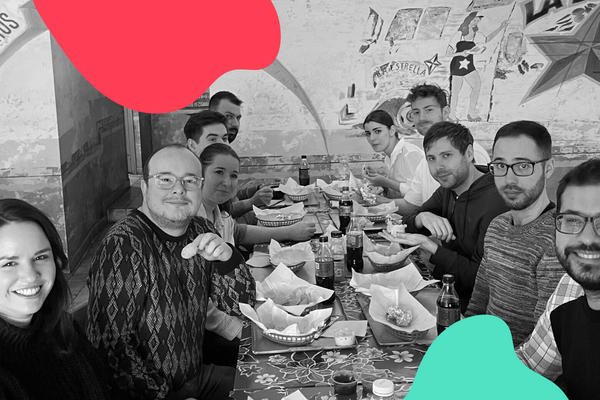An Inspirational Guide for Uncertain Times

Our CEO Balint Bene joins other thought leaders to help marketers and business owners navigate through rough waters. This article was originally published in the MarketingSherpa email newsletter, by Daniel Burstein, Senior Director, Content & Marketing, MarketingSherpa, and MECLABS Institute
“When will things get back to normal?” Have you heard that question a lot lately? I sure have.
Here’s my take on it — there is no normal. Things are always changing. That is the nature of the world and especially the marketing industry.
Yes, COVID-19 has sent shockwaves the world over changing how we greet, eat, meet and so much more. It has unsettled so many of us because it is a change felt by everyone, in every industry, in every country, all the time, with no clear end.
However, you have probably faced equally disruptive changes in your industry, your company or your job role. Perhaps your company was acquired or lost a major customer, or a new competitor entered your field and changed everything. New technology may have changed how you do your job or how customers access your product.
Major changes in your world generally don’t make the front page of the newspaper because these changes are far more niche.
My point is — yes, we live in uncertain times as a planet. But each one of us will always live in uncertain times in our careers and our businesses. There will never be a comfortable normal we can fall back into like a downy comforter on a crisp cold night.
So here are ideas and resources, with a heavy focus on our current global uncertainty, but also an understanding that the same general lessons can be applied to any other uncertainties that your career and business ventures throw your way.
Tip #1: You control the situation
None of these tips will help you if you’re not in the right frame of mind. So let’s start there.
“Tempest-tost.” That’s the best combination of words I’ve ever seen to explain what it feels like to go through times of uncertainty. The Free Dictionary defines that phrase to mean, “pounded or hit repeatedly by storms or adversities.” You can feel out of control, like a rudderless boat bobbing on a sea of uncertainty, the winds and waves taking you where they choose.
But if those words “tempest-tost” are familiar to you, it’s because they come from the sonnet “The New Colossus” by Emma Lazarus. That’s the poem on the Statue of Liberty.
You can’t thrive in uncertain times if you don’t realize the control you have. Lazarus’ poem was about immigrants — people who wouldn’t simply succumb to hard times and uncertainty in their own lands, who took their future in their own hands, and dared to venture to a faraway land to create their own destiny instead of leaving their fate to the trade winds, the “huddled masses yearning to breathe free.”
I wouldn’t be living my comfortable and safe life in this country without those daring immigrants. And many of you reading this article likely have a similar heritage.
So do not simply succumb to whatever uncertainty you’re facing. Yearn. Breathe free. You cannot control everything, but if you narrow it down to what you can control, you can attack those issues heartily.
As an example to inspire you, Flint McGlaughlin, CEO and Managing Director, MECLABS Institute, discusses what we can learn from Victor Frankl in The Hidden Opportunity Within the COVID-19 Crisis: Three ways to transform your work and your life. (MECLABS is the parent organization of MarketingSherpa). Frankl was a neurologist, psychiatrist and Holocaust survivor who wrote the book “Man’s Search for Meaning” (along with 38 other books) and developed a meaning-centered school of psychotherapy known as Logotherapy.
“Forces beyond your control can take away everything you possess except one thing, your freedom to choose how you will respond to the situation,” Frankl said.
I hope the following tips help you respond boldly.
Tip #2: Guide customers through the uncertainty
In situations where the customer is facing the same uncertainty as your business, you have an opportunity. If you can learn about and get a handle on the situation, you can help customers through it as well.
“As an accounting firm that helps companies with payroll, getting loans, etc., when the crisis hit, our clients had a ton of questions around the government’s stimulus programs. Instead of just answering these individually, we took everything we were learning about the stimulus and neatly organized them into a long, long blog post (that we keep continuously updated),” said Healy Jones, VP Marketing, Kruze Consulting.
They also paired the web content with newsletters that answered the important questions clients were asking and that highlighted important updates to federal laws.
“The results are that we’ve been growing through the crisis,” Jones said. “We are hearing from new prospects who were forwarded the email newsletters from people who we don’t even know, and also from prospects who are finding us by Googling technical questions around the federal stimulus package.”
Childcare management software Kangarootime took a similar approach. The team created a Facebook group open to all childcare professionals. They shared templates for parent communication and staff management.
The team then created a webinar series to help childcare professionals navigate this pandemic with programming that included everything from applying for a Paycheck Protection Program (PPP) loan to supporting staff members to developing a reopening strategy.
“We started building this community to help our customers and the industry as a whole, and we found out along the way that it was good for business too. We saw a 30% increase in leads from this time last year, which we didn’t anticipate at the beginning of the pandemic,” said Scott Wayman, CEO and Founder, Kangarootime.
Tip #3: Build resiliency into your business (and into yourself)
“When COVID first hit, we drew down severely on our paid social [advertising], and I’m confident today that decision cost us profitable sales,” said Sean McGinnis, Vice President and Head of Marketing, E-Commerce & Customer Experience, KURU.
Don’t panic in the face of uncertainty, McGinnis advises.
The more resiliency you’ve built into your business, the easier it is not to panic.
“More than any other business environment I’ve worked in, the online arena comes pre-packaged with an almost unbelievable number of uncertainties, from SEO issues (if/when Google updates its core algorithm, I could lose all of my rankings and much of my traffic) to volatile business relationships (when an affiliate drops their royalty rate, my income could [be] halved in an instant) to plain-old market whims (archery sales dry up quickly at the slightest hint of market downturn),” said Matthew Burke, Editorial Director, The Complete Guide to Archery.
You never know what the world will throw at you. The more resiliency you have built into your business — and your career and home life — the better you can weather any storm or pivot to benefit from changing market conditions.
“Be prepared and have a ready-to-use cash reserve. When we began to see people laid off from work, we realized people would probably stop buying archery equipment, and our sales would suffer. We were pleasantly surprised when the opposite happened: While there were fewer people buying archery goods, the number of people buying archery goods online skyrocketed, because every brick-and-mortar archery store in the country had to close its doors. Luckily, because we had a cash reserve, we were able to immediately increase our marketing spend, and our profits skyrocketed,” Burke said.
That resiliency allows you to act boldly and take a risk in times of uncertainty. “If you don’t know what’s going to happen next, other people probably don’t either, but at least you can move forward before your competition does. The markets hate uncertainty, but as a small business owner, you need to recognize its potential,” Burke said.
Building up that resiliency may also necessitate a change in your company’s goals and strategy.
“If you wanted to be a unicorn company, which is focusing on rapid growth instead of profitability, now it is time to pivot that strategy. The cockroach company serves essential customer needs so it can survive even a nuclear war,” said Balint Bene, Founder and CEO, bene : studio.
Tip #4: Understand how the uncertainty affects your marketing research
In an uncertain world, we will naturally seek certainty. One way to do that is with data and marketing research.
However, it’s important to understand how greater uncertainty in the macroeconomy or your industry will affect your marketing research. For example, if you engage in A/B testing, you should be aware of validity threats. They are so named because they threaten the validity, or accuracy, of your marketing research.
History effect — the effect on a test variable by an extraneous variable associated with the passage of time — can impact your marketing in the era of COVID-19 because the nature of customer demand may have inherently (or temporarily) changed. So tests you ran before COVID-19 may not accurately reflect how customers will respond during the pandemic, and tests you run now may not accurately reflect how customers will react in some unsure future state.
“To help you understand consumer perceptions, usage of your products, and the effect of today’s rapidly-changing reality on your segment and your brand, quick studies can help you decide whether to stay on course or pivot,” said Evelyn Chun, associate director, strategy and insights, Firewood Marketing.
During times of uncertainty, Chun recommends:
- Brand trackers
- Research related to the current climate
- Social tracking
- Media tracking
- Trend analyses
- Sales analyses
“However, research outputs and insights that are designed to inform longer-term business decisions are best paused [during uncertain times],” Chun says. This includes:
- Customer segmentations
- Evergreen message testing
- Product concept testing (unless it’s specifically designed to address the problems of “today”)
- Large brand change/repositioning tests
- Never-done-before, long-term studies like brand trackers and NPS (Net Promoter Score)
- Anything that requires in-person research (specifically for COVID-19, but may work during other times of uncertainty)
Here’s an example of running quick research. At the onset of the pandemic, Credit Sesame conducted daily surveys of more than 80,000 customers to stay apprised of their current pain points, priorities and financial goals.
The surveys revealed that consumers’ top three financial priorities since the crisis began were improving their credit score, paying down debt and saving money. The team learned that customers were concerned about their cashflow and maintaining their credit and were looking for help to manage both. They were looking for reliable resources on government assistance programs, especially the stimulus checks.
These discoveries helped drive the development of SesameThrive, a one-stop resource that includes budgeting tips and calculators, the latest on government assistance and other informational resources. The goal, according to Nicole Newby, PR Marketing Manager, Credit Sesame, is “to help consumers minimize the impact of COVID-19 while steering them on a path to financial stability and recovery.”
To date, more than two million customers have used SesameThrive and provided more than 3,000 comments.
“We wanted to make sure we [were] responding, not reacting. This allows us to provide value to our customers rather than just adding noise to the conversation,” Newby said.
Tip #5: Consider the environment in which the customer experiences your message
“Scroll through Twitter and you’ll likely find a consumer complaining about a brand’s ‘how we’re handling COVID-19’ email,” said Andrew Boni, co-founder, Iterable.
In times of uncertainty, it makes sense to want to inform the customer. But just remember that your company does not exist in a vacuum. The customers may already be getting inundated with messaging, and some of that messaging may come from companies and other relationships — like schools, workplaces, places of worship, etc. — that are much more important for them to hear from.
“Just like every meeting should start with a core question, ‘What are we hoping to accomplish here?’ every email sent should answer, ‘Does this matter to my customer?’” Boni said.
In addition, what is the proper tone you should use when communicating with the customer? Again, what are they going through, and how will they experience your message?
“With many people losing loved ones or jobs due to COVID-19, the tone of your campaigns carries more weight than ever before,” Boni said. “Take Popeyes, for example. The fast-food franchise fell flat with its COVID-19 response, offering to share its Netflix username and password to the first 1,000 fans that posted a photo of themselves eating Popeyes and tagging #ThatPasswordFromPopeyes.”
That doesn’t mean you have to only send serious information. You can humanize the uncertainty by transparently sharing how you and others in your company are getting through the situation.
“Sharing personal experiences or even funny stories about your own journey through the pandemic thus far can go a long way. A quick social post or email campaign about your own ups and downs in the last few months can make your customers feel closer to you. Chances are, they can likely relate to the challenges you’re going through on a human level,” said Dave Charest, Director of Content Marketing, Constant Contact.
Here is a free tool to help you produce empathetic marketing.
Tip #6: Uncertainty can bring opportunity
While uncertain times can feel like a negative, it can also bring opportunity, especially for outsiders. Steady times will tend to benefit the incumbent companies. And let’s be real; uncertainty can benefit incumbents as well, especially when the incumbents are large companies with deep cash reserves, ready access to shape government policy, and broad customer relationships.
However, that change can cause fissures in business as usual, which also could open an opportunity for you and your brand.
“Under normal circumstances, all the big players have covered every entrance point as best they can, and they have positioned themselves to keep everyone else out. When you get a big change, suddenly the needs and motivations of the public shift, and all sorts of unexpected openings start appearing. If you are fast, you can use the changed circumstances, and how slow big corporations are to respond, to wedge your small business in that opportunity while there is an opening in the market,” said Morgan Taylor, CMO, LetMeBank.
You may also find opportunity by slightly pivoting your offering using the expertise your company already has to serve customers in a new way during the uncertainty. “Look at your entire product portfolio and rethink positioning and packaging in light of the pressures facing your buyers. Be nimble by breaking down the traditional operating model to fit this new normal. Get creative and innovative when redesigning or repackaging how you put your products together so they can help solve the immediate needs of your customers,” suggested Alison Durant, SVP of Marketing, LogMeIn.
Here’s an example: SERVPRO offers fire and water cleanup and restoration services, and mold mitigation and remediation. But COVID-19 presented a new opportunity.
“In an effort to help businesses and organizations prepare to rebuild and reopen, we launched our Certified: SERVPRO Cleaned program last month — a robust, deep-cleaning program designed to help safely get the country back to work, school and life,” said Michael Stahl, Chief Marketing Officer, SERVPRO.
Tip #7: Have a customer-first mission
“Marketing during a crisis is trickier, but the best ways to market remain the same — you should focus less on yourself and more on your customers,” said Hardeep Johar, President, Stone & Tile Shoppe.
As you reflect on ways to improve individual tactics, don’t overlook the big picture. What is your organization’s approach to marketing as a whole? How do you treat customers? What’s your department’s North Star?
In our research with 2,400 customers, we discovered that customer-first marketing is the highest of the five levels of marketing maturity. If your company has a customer-first mission, don’t let it slide just because your brand is going through a time of upheaval.
“When times are uncertain or you’re facing a crisis, that’s when your mission needs to kick in. Find your North Star. We all have one, but it often gets lost when times are good and we’re just doing the work. When times are difficult, it’s important to communicate clearly, be transparent and reorient towards your long-term goals (even if those need to be adjusted) because the short term can often be unpredictable,” said Kristen Elworthy, marketing & publicity consultant, Seven Hills Communications.
“That’s where having that mission or North Star comes in. You’ll very rarely have a communications issue if the mission of your business is top of mind each day. It will remind people why they love your brand. And it will provide you with the ability to plan long-term even when things feel overwhelming day to day,” she said.
Join our team, we are hiring






